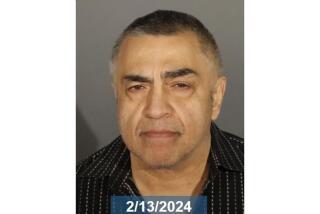Elusive Drug Dealer Killed Himself
When Johnnie Leroy Caldwell was finally cornered by sheriff’s deputies, U.S. marshals and federal drug agents Sunday afternoon in Alpine, the federal fugitive known for his daring escapes had only one way out, and he took it.
Caldwell put a .357 magnum in his mouth and pulled the trigger, a coroner’s spokesman said Monday.
Seconds later, Caldwell was hit by a shower of shotgun pellets from sheriff’s deputies who had surrounded the Datsun sports car in which he was riding. But Deputy Coroner Robert Engel said none of the shotgun wounds to Caldwell’s head, shoulder, elbow, thigh and back penetrated a vital organ.
After an autopsy Monday, his death was pronounced a suicide.
Caldwell, 41, had brazenly blown up two homes to cover his escapes from drug agents and evaded a 70-man search force for five days in the rugged hills near Alpine. But he was described by a friend not long ago as “a man of intelligence and sensitivity.”
Seeking an early end to a five-year prison sentence for drug possession, Caldwell in 1982 presented letters from friends, former employers and his wife of less than a year, all of whom said they believed in his promise to live a clean, family-oriented life when released from custody in Arizona.
Attempts to reach Caldwell’s associates were unsuccessful Monday. But the papers filed in federal court in connection with his case paint a picture, not of a violent recluse but of a gentle, friendly man who looked forward to leading a normal, crime-free life.
Caldwell, a longtime resident of the South Bay, was a construction worker who raced motorcycles for fun and dreamed of earning a contractor’s license. One friend trusted him enough to put up his own home as security when Caldwell needed $15,000 bail after his arrest on drug charges in 1980.
“He is a productive citizen, and I have put my life in his hands several times with the utmost confidence,” wrote Robert Anson, who said he and Caldwell, fellow motorcyclists, were “the best of friends” for 12 years. “If anyone needs help or advice, he is always there with a helping hand.”
Darlene Martin married Caldwell in 1981 while he was awaiting sentencing. He had been convicted on a drug possession charge after agents of the U.S. Drug Enforcement Agency arranged to buy a pound of methamphetamine--better known as speed --from a friend who got the drugs from Caldwell.
“John introduced himself to me not as a person awaiting a sentence that might send him to prison, but rather as a person with a strong desire to grow, to understand who he is and why he is here,” his wife wrote of the time they met in the fall of 1981. “I was attracted to a man who I perceived as a caring, sensitive, intense, intelligent and beautiful human being. I have not been wrong.”
At the same time, the construction company that had employed Caldwell for 10 years promised to give him a job if he were released early from prison.
“John is reliable, conscientious, friendly and a true pro in the profession of drywall,” wrote his supervisor. “John will always have a job with us as long as there is work on the horizon.”
But Caldwell’s plea for an early release was denied, and when his term ended in October, he returned to his home in Chula Vista and, apparently, to the crimes that had led to his imprisonment.
By Nov. 2, Caldwell was already suspected of manufacturing speed at his condominium on Third Avenue in Chula Vista. Drug agents surrounded the home that day and, as they were about to enter, they noticed the odor of ether. The agents evacuated the complex just before the condominium exploded in a fire set by Caldwell, who used the confusion to cover his escape as he jumped from the third to the second floor, through a vacant condominium and out a back stairway.
Caldwell then made his way to Alpine, where, according to a spokesman for the DEA, he set up shop again in a rented home, making speed in two-pound batches that would fetch about $10,000 a pound if sold wholesale.
Before long, though, drug agents were on Caldwell’s tail again, and, leery of his tactics, they surrounded the home before dawn Wednesday morning. Twenty deputies from the Sheriff Department’s Special Enforcement Team were brought in, and a negotiator called the home just after 4 a.m.
Someone picked up the phone but no one answered. A short time later, deputies saw fire coming from the house and the flames were followed by a violent explosion. Once again, Caldwell escaped.
The deputies called in more men and, with U.S. marshals, drug enforcement agents and the Border Patrol, the force swelled to as many as 70. They combed the hills by day and left a small group to patrol by night, but they couldn’t corner Caldwell, who was being described as a survivalist who had hidden food, water and weapons in remote caves in the Cleveland National Forest.
On Friday, Caldwell was confronted by a sheriff’s deputy at the entrance to a cave. Caldwell emerged, pointing a handgun at the deputy, who threw himself to the ground and rolled from Caldwell’s view. Caldwell then took refuge in a brush-covered ravine, from which he fired six shots at a Sheriff’s Department helicopter.
He escaped again and evaded authorities for two more days, until they saw him enter a woman’s car at noon Sunday. A roadblock was established at a remote section of Lyons Valley Road. The car was stopped and Caldwell was ordered to give himself up.
But Caldwell, whose determination to avoid capture was well-established, wasn’t about to surrender to police. He shot himself instead, authorities said.
More to Read
Sign up for Essential California
The most important California stories and recommendations in your inbox every morning.
You may occasionally receive promotional content from the Los Angeles Times.









